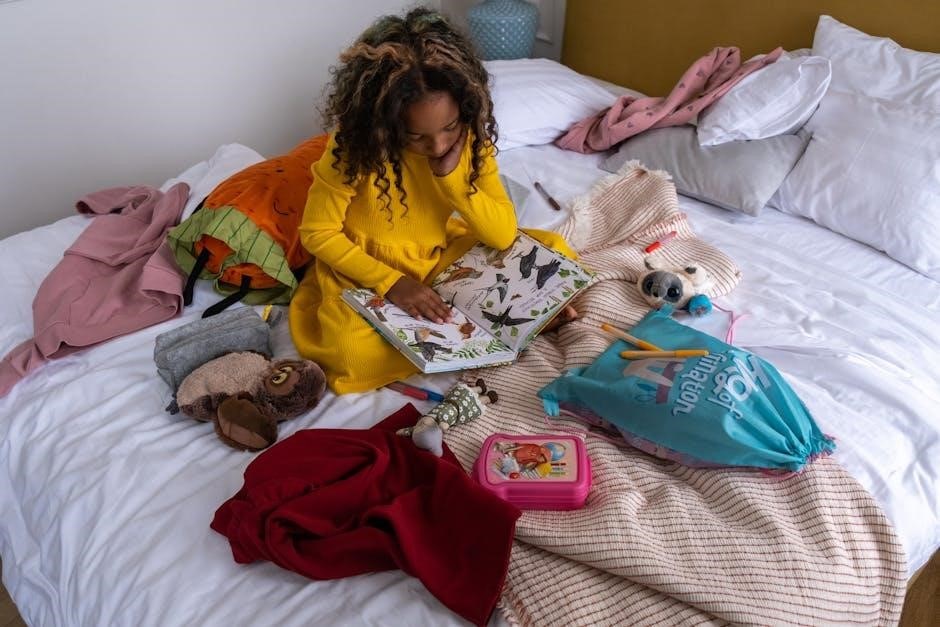Welcome to the “Alone” Movie Parents Guide, designed to help families make informed decisions about viewing this film․ This guide provides insights into themes, content, and discussions to support mindful parenting and ensure a positive viewing experience for all ages․
Overview of the Movie
“Alone” follows a young girl stranded in the wilderness, battling harsh conditions and personal fears․ The film explores themes of survival, isolation, and self-discovery, blending suspense with emotional depth․ It’s a gripping tale of resilience, offering both thrilling moments and reflective pauses, making it a thought-provoking watch for audiences of various ages․
Importance of a Parents Guide
A parents guide is essential for understanding the suitability of “Alone” for children․ It provides insights into the movie’s content, themes, and potential sensitive scenes, helping parents decide if it’s appropriate for their child․ This guide also offers tips for discussions, ensuring kids grasp the film’s messages while staying protected from inappropriate or overwhelming material․
Movie Summary and Genre
“Alone” follows a woman being stalked in her home, blending tension and suspense․ It falls under the thriller genre, offering a gripping yet intense viewing experience․
Plot Overview
The film centers around a woman being stalked in her home, emphasizing her struggle to protect herself․ The plot builds suspense as the stalker’s actions escalate, creating a tense atmosphere․
The story focuses on her efforts to survive and outsmart her assailant, highlighting themes of isolation and fear․
Genre and Tone
“Alone” falls under the thriller genre, with a tone that is intense and suspenseful․ The film creates a tense atmosphere, focusing on fear and anxiety․ Its gripping narrative keeps viewers on edge, making it a classic thriller experience․ The tone emphasizes isolation and danger, heightening the emotional impact for audiences․

Age Appropriateness
“Alone” is an intense thriller, making it more suitable for mature audiences․ Parental discretion is advised for younger viewers due to its suspenseful and potentially unsettling content․
Recommended Age Group
The film is best suited for viewers aged 16 and above due to its suspenseful and intense nature․ Younger teens may find certain scenes unsettling, so parental discretion is advised․ Mature teenagers, however, can handle the content with proper guidance․ Consider your child’s sensitivity and ability to process thrilling sequences before allowing them to watch․
Mature Themes and Content
The movie explores mature themes like isolation, survival, and emotional distress, which may be challenging for younger audiences․ Scenes of suspense and intense situations are present, requiring parental guidance․ The film’s focus on personal struggle and perseverance is thought-provoking but may not be suitable for all children due to its complex and emotionally charged nature․
Positive Themes for Discussion
The film highlights resilience, survival skills, and emotional growth, offering valuable topics for family discussions about overcoming adversity and self-discovery․

Resilience and Survival Skills
The movie showcases the protagonist’s remarkable ability to adapt and survive in isolation, demonstrating resourcefulness, determination, and courage․ These themes inspire young viewers to embrace challenges and persevere through adversity, teaching valuable life lessons about self-reliance and problem-solving․ The film highlights how resilience can lead to personal growth and triumph over overwhelming odds․
Emotional Growth and Self-Discovery
The movie beautifully portrays the protagonist’s emotional journey, illustrating how isolation fosters self-reflection and deeper understanding of oneself․ This transformation from fear to acceptance offers a powerful lesson for children, encouraging them to embrace their emotions and seek self-awareness, which are crucial for personal growth and emotional well-being․
Content Warnings for Parents
This section highlights key content concerns, ensuring parents are aware of potentially sensitive material, helping them decide if the film is suitable for their child․
Violence and Intense Scenes
The film contains suspenseful and intense moments, including physical confrontations and emotional distress, which may unsettle younger or sensitive viewers․ Parents should be aware of these scenes to assess suitability for their child․
Language and Dialogue
The film features minimal dialogue due to its isolated premise, but some scenes include strong language and tense exchanges․ Parents should review the script or watch beforehand to assess if the language aligns with their child’s sensitivity and household standards․
Mature or Sensitive Topics
The movie explores themes of isolation, survival, and emotional distress, which may be intense for younger viewers․ Scenes depicting the protagonist’s mental struggle and the harsh realities of being alone could be unsettling․ Parents should consider their child’s emotional maturity before allowing them to watch․

Parental Guidance and Viewing Tips
Encourage open conversations and set boundaries to ensure a safe viewing experience․ Watching together allows parents to address concerns and guide their child’s understanding of the film’s content․
Watching the Movie Together
Watching “Alone” with your child fosters a shared experience, allowing for real-time discussions and emotional support․ It helps parents gauge their child’s reactions and address any concerns immediately, ensuring the content is processed in a safe and guided environment․ This collaborative viewing enhances understanding and strengthens parent-child communication about complex themes and scenes․
Preparing Your Child for the Content
Before watching “Alone,” discuss the movie’s themes and potential intense scenes with your child․ Explain the context and reassure them about fictional elements․ This preparation helps children understand the story’s purpose and reduces anxiety, allowing them to engage more thoughtfully with the narrative and its emotional depth․

Educational Value
The film “Alone” offers valuable lessons on survival, resilience, and self-reliance, making it a tool for teaching critical thinking and real-world problem-solving skills to young viewers․
Learning Opportunities from the Plot
The plot of “Alone” offers rich opportunities for learning, such as understanding survival techniques, problem-solving strategies, and the importance of adaptability․ It also highlights themes of resilience and resourcefulness, encouraging children to think critically about how to handle challenges․ The story can spark discussions about decision-making, courage, and the human spirit, providing valuable life lessons for young viewers․
Discussing Real-World Applications
The movie “Alone” provides opportunities to discuss real-world applications, such as survival skills, emergency preparedness, and mental resilience․ Parents can use the film to teach practical lessons about staying calm in crises and problem-solving under pressure․ It also opens conversations about isolation, self-reliance, and how to handle natural disasters or unexpected challenges, making it a valuable tool for life skills education․

Comparing the Movie to the Book
This section explores how the film adaptation of “Alone” differs from the book, focusing on storytelling, character depth, and pacing to help parents understand which medium might be more suitable for their children․
Key Differences Between the Two
The movie “Alone” simplifies the book’s complex narrative, omitting certain subplots and characters․ While the book delves deeper into the protagonist’s internal struggles, the film focuses more on action and suspense, altering the pacing and tone․ Some themes are less explored in the movie, making the book a richer source for emotional and psychological insights․
Which is More Suitable for Children?
The movie “Alone” is generally more suitable for children due to its streamlined plot and focus on suspense rather than deep emotional complexity․ However, the book explores darker themes and internal struggles in greater detail, which may be more challenging for younger audiences․ Parents should consider their child’s sensitivity and maturity level when choosing between the two․
Role Models and Character Analysis
The protagonist in “Alone” serves as a strong role model, showcasing resilience and determination․ Their journey offers valuable lessons on perseverance and self-reliance for young viewers․
Positive Role Models in the Movie
The main character in “Alone” exemplifies resilience and determination, making them a compelling role model․ Their ability to adapt and solve problems under extreme conditions highlights resourcefulness and courage, offering valuable lessons for young viewers about perseverance and self-reliance․
Lessons from the Main Character
The main character’s journey in “Alone” teaches valuable lessons about resourcefulness, problem-solving, and emotional resilience․ Their ability to stay focused and adapt to challenges highlights the importance of determination and self-reliance․ These traits serve as powerful examples for children to emulate, fostering confidence and a growth mindset in overcoming adversity․

Safety and Fear Factors
The movie’s intense scenes and suspenseful moments may instill fear in young viewers, making it crucial for parents to evaluate these elements for sensitivity․
Scenes That Might Scare Children
The film features intense moments of isolation, sudden noises, and suspenseful chases, which may frighten younger audiences․ Dark settings and the protagonist’s vulnerability could heighten anxiety in sensitive children․ Parents should be prepared to address potential fears and reassure their kids during or after viewing these unsettling scenes․
How to Address Fears After Watching
After the movie, acknowledge your child’s feelings and reassure them that the story is fictional․ Encourage open discussions about their fears and provide comfort․ Highlight the protagonist’s survival skills and resilience to shift focus from fear to empowerment․ Offer physical reassurance, like hugs, and remind them they are safe․ This helps children process emotions healthily and feel secure․
Social and Emotional Learning
The film offers valuable lessons in empathy, self-awareness, and coping with isolation․ It encourages discussions about understanding others’ struggles and developing emotional resilience in challenging situations․
Understanding the Protagonist’s Journey
The protagonist’s journey in “Alone” is a powerful exploration of isolation, survival, and self-discovery․ As they navigate their challenges, viewers can reflect on how the character’s emotions and decisions mirror real-life struggles, fostering empathy and deeper understanding of personal growth and resilience in the face of adversity․
Teaching Empathy Through the Story
The story of “Alone” offers a unique opportunity to teach empathy by exploring the protagonist’s emotional struggles and isolation․ Parents can guide children to reflect on the character’s feelings, fostering understanding of loneliness and resilience․ Encourage discussions about how the protagonist’s experiences might mirror real-life situations, helping kids develop compassion and connection with others’ emotional journeys․
Parental Discretion and Personal Judgment
Parents should exercise discretion when deciding if “Alone” is suitable for their child, considering their sensitivity and maturity levels to ensure an appropriate viewing experience․
Knowing Your Child’s Sensitivity Level
Understanding your child’s sensitivity is crucial․ Consider their emotional maturity and how they react to intense scenes or themes․ Reflect on past reactions to similar content to gauge their readiness for “Alone․” Each child is unique, so tailor your approach based on their individual needs and responses to ensure a comfortable viewing experience․
Making an Informed Decision

Making an informed decision involves evaluating the movie’s content, your child’s sensitivity, and their ability to process complex themes; Consider their maturity level, emotional readiness, and how they might respond to intense or emotional scenes․ Balance entertainment with education, ensuring the film aligns with your child’s values and developmental stage for a positive experience․

Post-Movie Discussion Guide
A post-movie discussion guide helps parents engage children in meaningful conversations about the film’s themes, emotions, and lessons․ It fosters critical thinking and emotional understanding, encouraging open dialogue and reflection on the story’s impact and messages․
Questions to Ask Your Child
Engage your child with thoughtful questions like, “What was your favorite part of the movie?” or “How do you think the main character felt during tough moments?” Ask about lessons learned, how they would handle similar challenges, and what they think the movie is trying to teach․ These questions encourage reflection and deeper understanding of the story’s themes and messages․
Encouraging Critical Thinking
Encourage your child to think deeply about the movie by discussing the protagonist’s decisions, the consequences of their actions, and the moral dilemmas presented․ Ask open-ended questions like, “What would you do in their situation?” or “Why do you think the character made that choice?” This helps develop analytical skills and fosters a deeper understanding of the story’s themes and messages․
Alternative Viewing Options
If “Alone” is too intense, consider similar yet less intense films that explore survival and resilience, offering a more age-appropriate experience for younger viewers․
Suggesting Similar but Less Intense Films
For a gentler experience, consider films like The Martian or Cast Away, which focus on survival and resilience without extreme intensity․ These movies offer engaging stories while maintaining a tone suitable for younger audiences, making them excellent alternatives for families seeking similar themes without the mature content found in “Alone․”
Choosing the Right Time to Watch
Consider your child’s mood and sensitivity when selecting a viewing time․ Opt for a calm, stress-free evening to help them process the film’s intensity․ Ensure they are well-rested to maintain focus and emotional resilience․ Create a comfortable environment to foster open discussions afterward, addressing any fears or questions they may have․
Final Thoughts for Parents
“Alone” offers a compelling mix of entertainment and reflection, making it a valuable tool for sparking meaningful conversations with your child․ Use this guide to navigate its themes thoughtfully and foster a deeper understanding of its message, ensuring a enriching experience for the whole family․
Balancing Entertainment and Education
“Alone” strikes a balance between gripping entertainment and meaningful education, offering a story that captivates while prompting reflection on survival, resilience, and human nature․ Parents can use the film to entertain their children while sparking conversations about its deeper themes, making it a valuable tool for blending enjoyment with learning and personal growth․
The Value of Shared Viewing Experiences
Watching “Alone” together as a family fosters bonding and creates opportunities for meaningful conversations․ Shared viewing experiences allow parents to guide their children through complex themes, helping them process emotions and ideas․ This collective engagement not only strengthens relationships but also encourages empathy, reflection, and a deeper understanding of the story’s message․
In conclusion, the “Alone” Movie Parents Guide equips families with essential insights to navigate the film’s themes and content thoughtfully, promoting mindful viewing and open dialogue․
Recap of Key Points
This recap highlights the essential considerations for parents, including age appropriateness, mature themes, positive messages, and practical viewing tips․ It emphasizes the importance of understanding the film’s content to make informed decisions, ensuring a safe and enriching experience for children while fostering meaningful conversations about resilience, empathy, and personal growth․

Encouraging Mindful Parenting
Mindful parenting involves being present and attentive to your child’s needs, especially when introducing media like “Alone․” By fostering open conversations and guiding their emotional responses, you create a safe space for them to process complex themes; This approach helps balance entertainment with education, ensuring the film becomes a tool for growth, understanding, and shared learning experiences․


